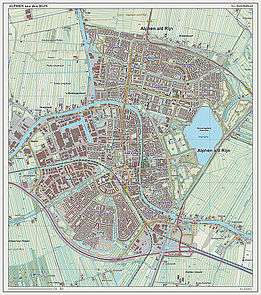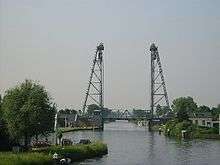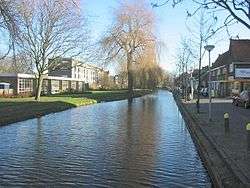Alphen aan den Rijn
| Alphen aan den Rijn | |||
|---|---|---|---|
| Municipality | |||
|
Aar and Aarkade | |||
| |||
.png) Location in South Holland | |||
| Coordinates: 52°8′N 4°40′E / 52.133°N 4.667°ECoordinates: 52°8′N 4°40′E / 52.133°N 4.667°E | |||
| Country | Netherlands | ||
| Province | South Holland | ||
| Government[1] | |||
| • Body | Municipal council | ||
| • Mayor | Liesbeth Spies (CDA) | ||
| Area[2] | |||
| • Total | 132.49 km2 (51.15 sq mi) | ||
| • Land | 126.58 km2 (48.87 sq mi) | ||
| • Water | 5.91 km2 (2.28 sq mi) | ||
| Elevation[3] | 2 m (7 ft) | ||
| Population (May 2014)[4] | |||
| • Total | 107,117 | ||
| • Density | 846/km2 (2,190/sq mi) | ||
| Demonym(s) | Alphenaar | ||
| Time zone | CET (UTC+1) | ||
| • Summer (DST) | CEST (UTC+2) | ||
| Postcode | 2390–2409, 2445, 2470–2471, 2730–2731, 2770–2771 | ||
| Area code | 0172 | ||
| Website |
www | ||

Alphen aan den Rijn (Dutch pronunciation: [ˈɑlfə(n) aːn də ˈrɛi̯n], English: Alphen on the Rhine) is a town and municipality in the western Netherlands, in the province of South Holland, between Leiden and Utrecht. The town is situated on the banks of the river Oude Rijn (Old Rhine), where the river Gouwe branches off. The municipality had a population of 107,117 in 2014, and covers an area of 132.49 km2 (51.15 sq mi) of which 5.91 km2 (2.28 sq mi) is water.
The municipality of Alphen aan den Rijn also includes the communities of Aarlanderveen, Zwammerdam and Boskoop. The town is located in what is called the 'Green Heart' of the Netherlands, which is a somewhat less densely populated centre area of the Randstad.
The name "Alphen" is probably derived from the name of the Roman fort Albaniana, meaning "settlement at the white water". Its remains still lie underneath the city centre today.
History

The area around Alphen aan den Rijn has been inhabited for 2000 years. In the Roman era, the Oude Rijn was the main branch of the Rhine River and formed the north border of the Roman Empire. Since the rule of Emperor Claudius (41–54 AD), divisions of the Roman army were stationed here. Consequently, several Roman fortifications were located along the Oude Rijn, including castellum Albanianae in the centre of Alphen. The Romans had also built the first bridge over the Oude Rijn. Alphen was therefore an important commercial site in the area until Germanic raids ended that in 240 AD.
After recurring problems with flooding, especially in Utrecht and Leiden, the Oude Rijn was dammed at Wijk bij Duurstede in 1122, thereby making the Lek River the main branch of the Rhine. The Oude Rijn has not flooded since. During the Middle Ages, Alphen was a fiefdom called Alphen en Rietveld.

In the 17th century, Alphen became prominent again as a hub for commerce. The Oude Rijn was used for boat traffic; there are still portions along the river where the towpath is present.
The current municipality was formed in 1918 through the amalgamation of the smaller municipalities of Alphen, Aarlanderveen, and Oudshoorn. In 1964, the municipality of Zwammerdam was added as well. In 2014 the municipalities of Boskoop and Rijnwoude were amalgamated as well, doubling the land area and increasing the population to over 100,000.
During the Second World War, the majority of Jews from Alphen were deported and subsequently murdered; only a few survived. After the war, the Jewish congregation was disbanded and merged with the one in Leiden. A Jewish cemetery on the Aarkade was founded in 1802, but it was abandoned and razed in the 1960s, with the remains re-interred in Katwijk;[5] in 2012, after fifteen years of community activism by local historian Anke Bakker and CDA council member Alice Besseling, a monument was installed and the area turned into a city park.[6]
Since 1950, the city began to grow rapidly. A large new neighbourhood was built on the north side. And since the 1990s, a similar new development was built at the city's south side. Now Alphen aan den Rijn is mostly a commuter city.

In recent years, a large part of the town centre has undergone a full urban renewal. Many older buildings built in the 1950s and earlier have been demolished to make place for modern architecture. This "masterplan" included the addition of a new public square next to the riverbank, the construction of a performing arts theatre/cinema, an upgrade of local shops and the creation of pedestrian streets. As of 2006, all of these projects have been finished.
On 9 April 2011, a gunman opened fire at a shopping centre in Alphen aan den Rijn, killing six people and subsequently taking his own life.[7]
On 3 August 2015, the city made international headlines when a section of the under-renovation Juliana Bridge hoisted by two cranes, floating on a pontoon on the Oude Rijn (a former bend in the river Rhine) fell and collapsed onto buildings. After initial fears of mass injuries and fatalities, it was established that there were none, except that of a Dog from Düsseldorf, although 51 properties were damaged.[8][9]
Demographics
- Native white people: 80.7%
- Non-native white people and second-generation descendants: 8.9%
- Turkish people: 1.3%
- Moroccan people: 2.7%
- Surinamese people: 1.8%
- People from the Netherlands Antilles and Aruba: 0.9
- Other non-caucasian non-natives: 3.7% [10]
Tourism
Alphen aan den Rijn has the following attractions:
- Avifauna Bird Park – the world's first dedicated bird park, opened in 1950.
- Archeon – a theme park about Dutch History, with 43 replica buildings from prehistoric, Roman, and Medieval eras. It opened in 1994.
- Zegersloot Recreation Park – park with an artificial lake, popular for hiking, cycling, windsurfing, wakeboarding and water skiing.
Events
- 20 van Alphen – International 20 kilometres run. Held every year (since 1952) on the second Sunday of March. The 2006 event was marked by a world record when Haile Gebrselassie posted a time of 1 hour 11 minutes 37 seconds for 25 km. This was his 22nd world record breaking performance.
- Year market – third Wednesday in September. Regional products.
- Lakeside Festival – end of August. Music festival near Zegersloot.
- Old timer day – second Saturday of September. Old cars, tractors, steam engines.
- LAURA – four-day bicycle event Leiden, Amsterdam, Utrecht, Rotterdam and Alphen aan den Rijn which is the start and finish place, is held the first week of July.
- Tean International – Challenger level ATP Tour tennis tournament, played at the Alphense Tennis Club, from 30 August to 8 September 2008.
- Midwinter Fair and Midzomer Fair[11] – Fantasy festivals at the Archeon.
- Vakantiespel – One of the largest events for children between 6 and 12 year old in the Netherlands. Held every year in August.
Public transport
The town is served by Alphen aan den Rijn railway station. It is just south east of the town centre. The bus station is located near the railway station.
Politics
In total, there are 11 parties in the city council that consists of 35 councillors. Liesbeth Spies of the CDA is the current acting mayor. The council of mayor and alderman run the city on a day-to-day basis and report to the city council.
Current (2016) aldermen in Alphen aan den Rijn are:
- M.H. du Chatinier (ChristenUnie)
- C.J. van Velzen (CDA)
- G. van As (Nieuw Elan)
- T. Hoekstra (VVD)
- H. de Jager (CDA)
- E. de Leest (D66 - since 21-04-2016 instead of W.J. Stegeman)
Economy
The information and publishing company Wolters Kluwer is based in Alphen aan den Rijn.
Notable natives
- J.C. Bloem (1887–1966), poet
- Petrus Wernink (1895–1971), sailor
- Matthijs van Heijningen (born 1944), film producer
- Wouter van Pelt (born 1968), hockey player
- Arjan van Heusden (born 1972), footballer
- Evert-Jan 't Hoen (born 1975), baseball player
- Wilbert Pennings (born 1975), high jumper
- Jeannette Pennings (born 1977), athlete
- Martin Verkerk (born 1978), tennis player
- Salah Edin (born 1981), rapper
- John Heitinga (born 1983), footballer
References
- ↑ "J.W.E. (Liesbeth) Spies". College (in Dutch). Gemeente Alphen aan den Rijn. Archived from the original on 29 January 2015. Retrieved 28 January 2015.
- ↑ "Kerncijfers wijken en buurten" [Key figures for neighbourhoods]. CBS Statline (in Dutch). CBS. 2 July 2013. Retrieved 12 March 2014.
- ↑ "Postcodetool for 2405SH". Actueel Hoogtebestand Nederland (in Dutch). Het Waterschapshuis. Retrieved 11 February 2013.
- ↑ "Bevolkingsontwikkeling; regio per maand" [Population growth; regions per month]. CBS Statline (in Dutch). CBS. 26 June 2014. Retrieved 24 July 2014.
- ↑ "Over een paar maanden is de begraafplaats een stadspark". Dichtbij.nl (in Dutch). 1 December 2011. Retrieved 31 January 2014.
- ↑ "Joodse begraafplaats omgevormd tot stadspark". Dichtbij.nl (in Dutch). 16 September 2012. Retrieved 31 January 2014.
- ↑ "Gunman Kills Six In Busy Shopping Centre". Sky News. 9 April 2011. Retrieved 9 April 2011.
A 24-year-old gunman has opened fire with a machine gun in a packed shopping centre in the Netherlands, killing six people and then himself.
- ↑ "Netherlands cranes collapse in Alphen aan den Rijn". BBC News. 3 August 2015. Retrieved 4 August 2015.
- ↑ "Investigation underway into Alpen a/d Rijn crane crash". Dutch News. 4 August 2015. Retrieved 6 August 2015.
- ↑ "Niet-westerse allochtonen per gemeente 2010–2040 [Non-western allochthones per municipality 2010–2040]". Nationale Atlas Volksgezondheid. Rijksinstituut voor Volksgezondheid en Milieu. Retrieved 7 December 2011.
- ↑ (Dutch) Midsummer Fair, Aztek-TV, 19 June 2010 (archive)
External links
| Wikivoyage has a travel guide for Alphen aan den Rijn. |
| Wikimedia Commons has media related to Alphen aan den Rijn. |
 |
Leiderdorp | Kaag en Braassem | Nieuwkoop |  |
| Zoeterwoude | |
|||
| ||||
| | ||||
| Zoetermeer | Zuidplas, Waddinxveen | Bodegraven-Reeuwijk |



